Beyond our work on rods, plates and shell, which derive their flexibility from their slenderness, we are also interested on the broader class of materials that are intrinsically compliant at the constitutive level: soft materials. Using soft materials such as elastomers and gels, we devise structural elements that can undergo extreme stretching to produce functional devices.
We have been particularly interested in using this large deformation for soft composites that enable tunable optical transmittance.
|
Compressible and electrically conducting fibers for large-area sensing of pressures with: Andreas Leber, Alexis Gérald Page, Dong Yan, Yunpeng Qu, Shahrzad Shadman, and Fabien Sorin |
 |
|
Flexible pressure sensors offer a wide application range in health monitoring and human–machine interaction. However, their implementation in functional textiles and wearable electronics is limited because existing devices are usually small, 0D elements, and pressure localization is only achieved through arrays of numerous sensors. Fiber‐based solutions are easier to integrate and electrically address, yet still suffer from limited performance and functionality. An asymmetric cross‐sectional design of compressible multimaterial fibers is demonstrated for the detection, quantification, and localization of kPa‐scale pressures over m2‐size surfaces. The scalable thermal drawing technique is employed to coprocess polymer composite electrodes within a soft thermoplastic elastomer support into long fibers with customizable architectures. Thanks to advanced mechanical analysis, the fiber microstructure can be tailored to respond in a predictable and reversible fashion to different pressure ranges and locations. The functionalization of large, flexible surfaces with the 1D sensors is demonstrated by measuring pressures on a gymnastic mat for the monitoring of body position, posture, and motion. Publications: |
|
Now I see you, now I don’t: a tuneable optical switch with: Francisco López Jiménez and Shanmugam Kumar |
|
|
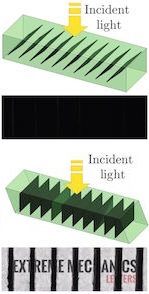
|
We introduce a soft composite that is actuated mechanically to achieve switchable and tunable optical transmittance. Our design comprises a series of parallel opaque platelets embedded into an optically clear solicone-based elastomer matrix. Under an applied shear loading, the platelets rotate, thereby gradually increasing the transmittance of light through the device, in a controllable and reversible manner. Experiments on a prototype device are used to support finite element simulations that explore the parameter space of the system towards providing a set of design guidelines. Specifically, we study how the optical transmittance depends on the stiffness mismatch between the matrix and the platelets, as well as their initial orientation and aspect ratio. We also focus on the maximum attainable value of transmittance and the energetic requirements to achieve it. Publications: |
|
Curvature-controlled defect localization in elastic surface crystals with: Francisco López Jiménez, Norbert Stoop, Denis Terwagne, Miha Brojan, Romain Lagrance and Jörn Dunkel |
|
|
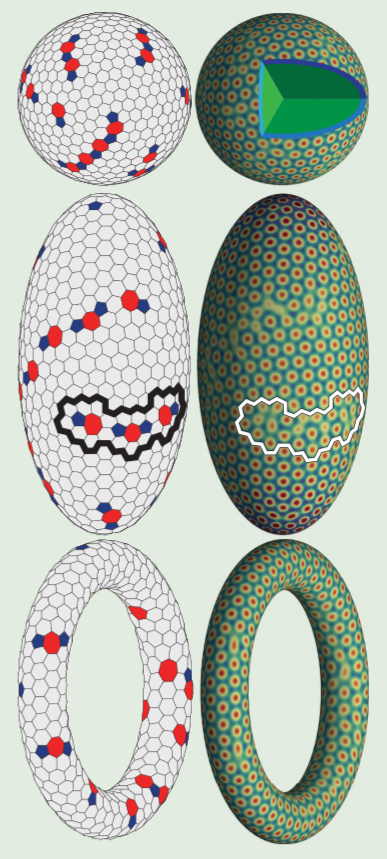
|
Curved crystals cannot comprise hexagons alone; additional defects are required by both topology and energetics that depend on the system size. These constraints are present in systems as diverse as virus capsules, soccer balls, and geodesic domes. We have study the structure of defects of the crystalline dimpled patterns that self-organize through curved wrinkling on a thin elastic shell bound to a compliant substrate. The dimples are treated as point-like packing units, even if the shell is a continuum. Our results provide quantitative evidence that our macroscopic wrinkling system can be mapped into and described within the framework of curved crystallography, albeit with some important differences attributed to the far- from-equilibrium nature of our patterns. Moreover, we have investigated the influence of curvature and topology on crystalline dimpled patterns on the surface of generic elastic bilayers. Our numerical analysis predicts that the total number of defects created by adiabatic compression exhibits universal quadratic scaling for spherical, ellipsoidal, and toroidal surfaces over a wide range of system sizes. However, both the localization of individual defects and the orientation of defect chains depend strongly on the local Gaussian curvature and its gradients across a surface. Our results imply that curvature and topology can be utilized to pattern defects in elastic materials, thus promising improved control over hierarchical bending, buckling, or folding processes. Generally, our work suggests that bilayer systems provide an inexpensive yet valuable experimental test bed for exploring the effects of geometrically induced forces on assemblies of topological charges. This project was done in collaboration with the group of Jörn Dunkel (MIT Math). Publications: |
|
Soft color composites with tunable optical transmittance with: Francisco López Jiménez and Shanmugam Kumar |
|
|
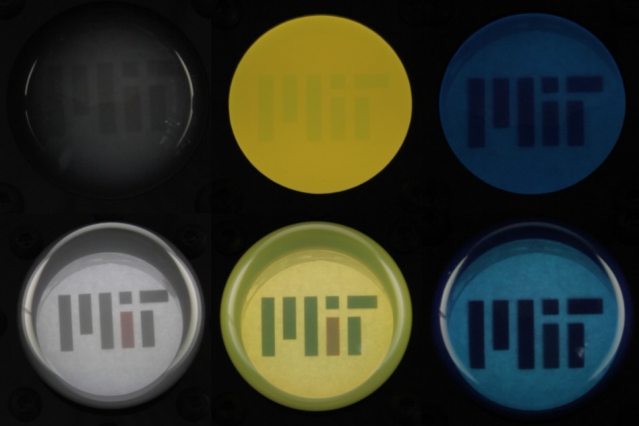
|
A class of soft color composites whose light transmittance can be actively tuned and controlled through mechanical actuation is studied. The design comprises thin sheets of polydimethylsiloxane, an optically clear silicone- based rubber, that is mixed with a colloidal suspension of black micrometer- sized dye particles to provide tunable opacity to the specimens. The thickness of the samples can be reduced by mechanical loading (e.g., pneumatically), which modulates the thickness and, in turn, the transmittance by as much as 40%. The mechanism is independent of the specific method of actuation chosen for loading. Scaling analysis and finite element modeling are combined to predictively describe and rationalize the evolution of the transmittance of our samples as a function of the applied mechanical loading and validate the predictions against biaxial tensile experiments. Compared to existing solutions, the main advantages of this mechanism are that it is remarkably simple and robust, as well as fast and fully reversible. Making use of this framework, pneumatic bulging is then chosen as a representative loading strategy, for which a series of design guidelines is presented, which may be implemented in practical applications, such as smart windows and other visually active materials. Publications: Press Coverage: |
|
Negative Poisson’s ratio materials with: Katia Berdoldi and Tom Mullin |
|
|
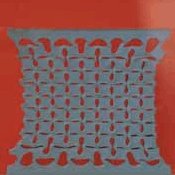
|
We have uncovered negative Poisson’s ratio (auxetic) behavior in cellular solids that comprise a solid matrix with a square array of circular voids. The simplicity of the fabrication implies robust behavior, which is relevant over a range of scales. The behavior results from an elastic instability, which induces a pattern transformation and excellent quantitative agreement is found between experiment and numerical simulations. Publications: Press Coverage: |
|
Anticracks in solid foams with: Benoit Roman, Francis Corson, Arezki Boudadoud |
|
|
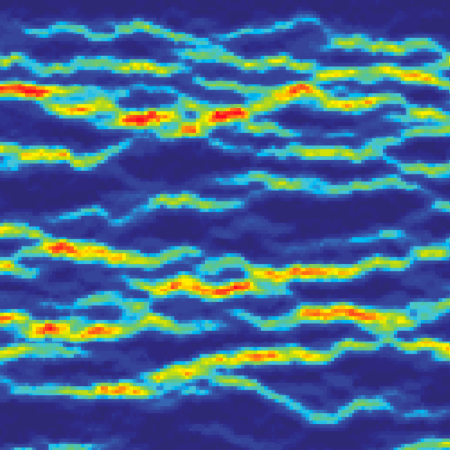
|
We report a combined experimental and theoretical study of the compression of a solid foam coated with a thin elastic film. Past a critical compression threshold, a pattern of localized folds emerges with a characteristic size that is imposed by an instability of the thin surface film. We perform optical surface measurements of the statistical properties of these localization zones and find that they are characterized by robust exponential tails in the strain distributions. Following a hybrid continuum and statistical approach, we develop a theory that accurately describes the nucleation and length scale of these structures and predicts the characteristic strains associated with the localized regions. Publications: |